PI Tangen, Maeke, Wagler, McCaskill BioMIP, RUB
In order to move to higher density electrode designs and support more flexible testing and voltage control (especially for the electrochemical experimentation) we have had to redesign our chemical microprocessors and their interface.

Figure 1: Optimized chemical microprocessor chip and its adapter PCB. The adapter PCB is connected directly to the BioFox board computer and/or to an electrochemical control system (e.g. cyclic voltammetry). The jumpers rows allow flexible choice of input and the FPGA programmable control sequences for the electrodes.
The main advantages of the new design are
- it is much easier to establish low-noise and variable voltage electrochemical interfaces to the chip
- integrated temperature control has a 64-bit unique identifier making a depository of such chips manageable
- the fabrication and assembly of the chip is significantly easier
- the FPGA has been moved to the adapter PCB, so that this frees up space and cost on each chemical microprocessor (more efficient and reliable packaging of integrated circuits)
